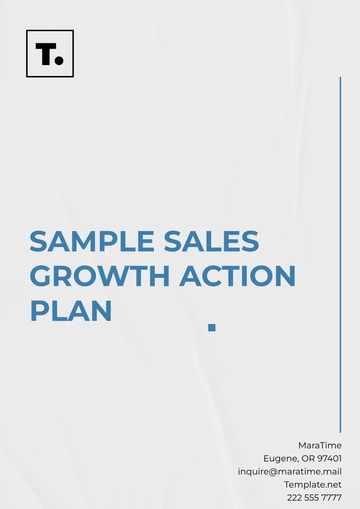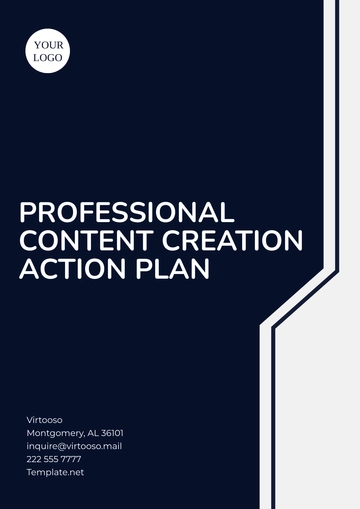Free Product Launch Brand Action Plan

Prepared by: [Your Name]
Company: [Your Company Name]
Date: [Date]
1. Executive Summary
This document outlines the comprehensive strategy for the successful launch of Product X, a cutting-edge smart wearable device designed to enhance users' daily health and fitness experiences. Our goal is to establish Product X as the leader in the wearable technology market, achieving a 5% market share within the first year of launch. The strategy integrates marketing, sales, logistics, and after-sales support to ensure a strong market entry and effective brand positioning, focusing on customer satisfaction and sustained growth.
2. Market Analysis
2.1 Industry Overview
The wearable technology market is experiencing rapid growth, fueled by increasing health consciousness, advances in sensor technology, and the adoption of connected devices. The market is projected to grow at a CAGR of 15% from 2050 to 2055. Key trends include health and fitness tracking, sleep monitoring, and real-time health analytics. Consumers are looking for devices that seamlessly integrate into their daily lives, offering both convenience and functionality. The expansion of smart ecosystems also opens new opportunities for cross-device compatibility.
2.2 Competitor Analysis
Key Competitors:
Fitbit: Strong brand presence and market leader in fitness tracking. Strengths include a broad user base and reliable devices, but weaknesses include limited customization and outdated design.
Apple Watch: A premium product with a focus on health and fitness features. Strengths include brand loyalty, an integrated ecosystem, and advanced features like ECG monitoring. Weaknesses include a high price point and dependency on iPhone users.
Garmin: Known for its rugged, outdoor-focused products. Strengths include durable designs and GPS integration, but lacks the sleek design and broad appeal of competitors.
Market Positioning:
Product X will differentiate itself by offering a premium, affordable wearable with superior health tracking features and a sleek design that appeals to both fitness enthusiasts and casual users.
3. Target Audience
Primary Audience:
Age: 18–45
Income Level: Middle to upper-middle class
Demographics: Tech-savvy individuals, professionals, fitness enthusiasts
Psychographics: Health-conscious, performance-driven, early adopters of technology
Purchase Behavior: Prefers high-tech, multifunctional devices that support an active lifestyle, prioritizing product quality and brand reputation over price.
Secondary Audience:
Age: 45–60
Income Level: Upper-middle class
Demographics: Middle-aged individuals focused on health monitoring
Psychographics: Motivated by health and longevity, values data-driven insights to improve well-being
Purchase Behavior: Looks for easy-to-use devices with clear health benefits and simple integration with existing tech.
4. Branding Strategy
4.1 Brand Positioning
Product X will be positioned as an affordable premium wearable that combines advanced health features, sleek design, and user-friendly functionality. It will target health-conscious individuals who seek a balance between performance and lifestyle integration.
4.2 Key Messages
"Empowering your wellness journey"
"Track your fitness. Enhance your health. Live better."
"Wear the future of health on your wrist."
The product will emphasize health optimization, long-term fitness tracking, and seamless technology integration as its core unique selling propositions (USPs).
5. Marketing Plan
5.1 Digital Marketing
Social Media Campaigns: Launch targeted ads on Instagram, Facebook, and TikTok showcasing real user testimonials and product features. Collaborate with influencers in the fitness and tech space to build buzz.
Email Marketing: Build an email list of interested customers through website sign-ups, offering early-bird discounts and exclusive pre-order promotions.
SEO and Content Marketing: Optimize content around wearable tech, fitness trackers, and health optimization to rank high on search engines. Publish blogs, how-to guides, and expert interviews to drive traffic and engagement.
5.2 Traditional Marketing
Print Advertising: Advertise in fitness magazines, health and wellness publications, and tech-oriented magazines.
Television and Radio Spots: Develop short, catchy ads to air during prime-time slots on popular health and lifestyle channels.
Event Sponsorships: Sponsor marathons, fitness expos, and technology trade shows to showcase Product X to targeted audiences and create real-life engagement opportunities.
6. Sales Strategy
Sales Channels: Product X will be sold through e-commerce platforms (website, Amazon), and through strategic partnerships with major electronics retailers and fitness centers.
Partner Programs: Develop partnerships with gym chains and health insurance companies to offer discounts or promotional deals to customers.
Sales Force Training: Equip the sales team with in-depth product knowledge and customer engagement techniques, ensuring they can effectively communicate Product X’s value proposition.
7. Logistics and Operations
7.1 Supply Chain Management
Establish relationships with reliable suppliers for components and assembly. Prioritize quality control and minimize lead times to ensure on-time delivery.
Utilize 3PL (Third-Party Logistics) providers for warehousing and distribution to ensure efficient order fulfillment.
7.2 Inventory Management
Implement a just-in-time inventory system to reduce costs associated with overstocking. Use demand forecasting models to anticipate fluctuations in product demand.
8. Customer Support
Support Channels: Offer multi-channel support via live chat, email, and phone to assist customers with troubleshooting, product setup, and warranty inquiries.
Customer Satisfaction: Establish a feedback loop to continuously improve the product and customer experience. Provide a satisfaction guarantee with a 30-day free return policy to boost consumer confidence.
9. Financial Projections
Year | Projected Revenue | Projected Profit |
|---|---|---|
2050 | $1,000,000 | $200,000 |
2051 | $1,500,000 | $300,000 |
Assumptions:
20% growth rate in year-over-year revenue.
Initial costs are heavily weighted towards marketing and distribution.
Profit margins are expected to increase with brand recognition.
10. Timeline and Milestones
Milestone | Timeline |
|---|---|
Product Development Complete | March 2050 |
Manufacturing Begins | May 2050 |
First Marketing Campaign | June 2050 |
Product Launch | August 2050 |
Post-Launch Review | December 2050 |
11. Evaluation and Adjustment
Monitor KPIs such as website traffic, conversion rates, customer feedback, and return on investment (ROI).
Adjust marketing efforts based on campaign performance and customer insights.
Plan a quarterly review to evaluate the strategy and make necessary pivots to ensure sustained growth.
- 100% Customizable, free editor
- Access 1 Million+ Templates, photo’s & graphics
- Download or share as a template
- Click and replace photos, graphics, text, backgrounds
- Resize, crop, AI write & more
- Access advanced editor
The Product Launch Brand Action Plan Template from Template.net is a fully customizable tool designed to streamline your product launch process. This editable template allows you to tailor every detail to your brand's needs. Easily editable in our AI Editor Tool, it ensures a smooth and efficient planning experience to launch your product with confidence.





























